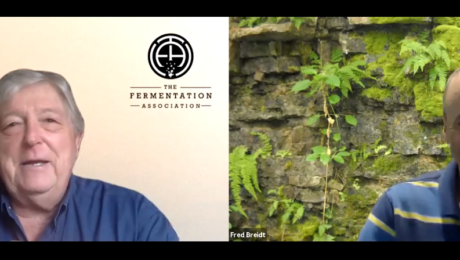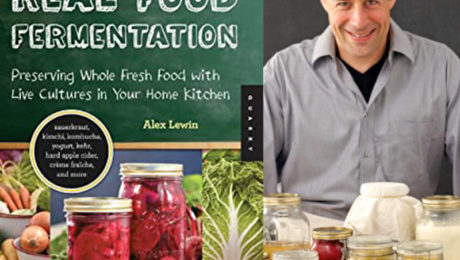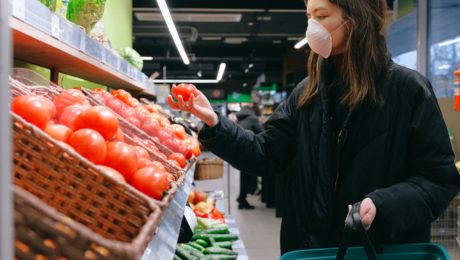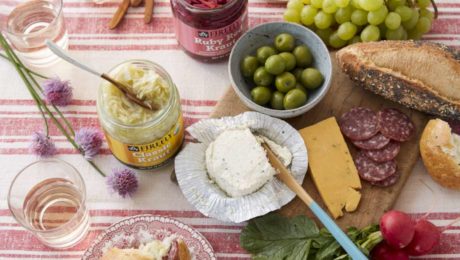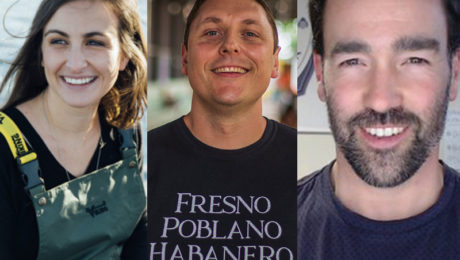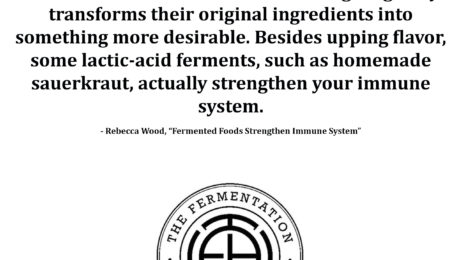Science Behind Fermented Vegetable Safety
Just because vegetables were fermented does not make them immune to harmful bacteria like E. coli. Though fermentation improves food safety, the quality of the raw vegetable before it’s fermented is extremely important.
“The issue of fermentation safety is one that comes up a lot. People are getting excited about the fermentation world these days, fermentation is increasing in popularity…(but) the wheels can fall off if you’re not careful,” says Fred Breidt, PhD, a USDA microbiologist. Breidt spoke during a recent webinar hosted by The Fermentation Association, “The Science Behind the Safety of Fermented Vegetables.” “The moral of the story: if the vegetables were safe to eat before you ferment them, they’re going to be safe to eat after you ferment them. If they’re not, you’ve got to ferment them for a long time to make sure they’re safe.”
An outbreak of dangerous bacteria in fermented vegetables, “it’s going to be pretty rare that that happens,” Breidt stresses. But, without proper sanitation protocol and vegetable quality control, pathogenic “bad guys” can flourish, like E. coli, salmonella and listeria. E. coli is more common in vegetables because it’s extremely acid resistant, and can survive for long periods of time at low pH levels and cold temperatures.
“Just washing the surface (of the vegetable) isn’t always going to do the trick,” Breidt says. “You don’t have to eat very much to get sick.”
An E. coli outbreak in kimchi made 230 Korean school children sick in 2013. The children, from seven different schools, all ate fermented kimchi made by the same manufacturer.
“If the folks had eaten the cabbage that this kimchi was made out of, they would have gotten sick as well,” Breidt says. “Was the cabbage improved in the sense of maybe it had fewer E. coli on it because of fermentation? Yes. But there was still enough when this was eaten to make a lot of people sick.”
“You can’t rely on salt for safety is the point,” he adds. “It does encourage the lactic acid bacteria and it helps them grow and it will increase overall the safety of your fermentation.”
David Ehreth, president and founder of Alexander Valley Gourmet, parent company of Sonoma Brinery, moderated the webinar. Ehreth first met Breidt when Sonoma Brinery made a few tons of sauerkraut that became infected with yeast. Ehreth says “I called Ghostbusters, and that’s Fred Breidt.” Though yeast is different from a pathogen like E. coli, Ehreth said Sonoma Brinery has managed to control yeast over the years by careful management of production techniques and improved sanitation methods.
- Published in Science
Study Links Low COVID Mortality to Fermented Veggies
A new study links lower COVID-19 deaths to countries where the diet is rich in fermented vegetables. Researchers in Europe found in countries where the national consumption of fermented vegetables is high, the mortality risk for COVID-19 decreased by 35.4%. Results are currently preliminary and undergoing peer review. But, if the hypothesis is confirmed, “COVID-19 will be the first infectious disease epidemic to involve biological mechanisms that are associated with a loss of ‘nature,'” reads an article in News Medical. “Significant changes in the microbiome caused by modern life and less fermented food consumption may have increased the spread or severity of the disease, (researchers) say.”
The study was led by Dr. Jean Bousquet, a professor of pulmonary medicine at Montpellier University in France. After researching that diet may play a big role in determining how well people can fight the coronavirus, Bousquet says he now eats fermented foods multiple times a week.
Read more (News Medical Life Sciences)
“Backslop Romance” — Inoculation, Not Contamination
By: Marina Jade Phillips, Trellis & Co.
The first two months of 2018 marked both my first trip to Mexico and my first bicycle tour. Living on two wheels did not slow my fermentation habit; I toted stainless steel jars of fermented vegetables in my panniers. I credit consuming lacto-bacteria with my lack of stomach troubles that can plague travelers in South America. Regularly introducing healthy bacteria into our digestive tract is a great way of inoculating our body with microbes that are on our team. The amount of attention probiotics have received in recent years is long overdue. Traditional cultures have known about the delicious and health-promoting qualities of fermented foods for hundreds of years, even before it was scientifically proven.
Backslop is Such Beautiful Word
Contamination and inoculation are two sides of the same food processing coin: the impact of a small quantity of the right or wrong material can be drastic. The former is the stuff of nightmares for food companies forced to recall tainted products, and suffering travelers perched atop or hunched over a toilet. The latter is how fermented flavors have been passed down through time, sometimes across generations, from one bottle, crock, or barrel to the next. Inoculation is so ubiquitous to the craft that traditional sausage makers gave it a name: backslop.
Backslop, unsavory as it may sound, simply refers to the practice of saving a bit of the last successful batch and incorporating it into the new one, ensuring a small number of the micro-organisms that populated the previous batch will go forth and multiply. There are several reasons why this technique is valuable to both professionals and home cooks. Foremost, the time required for complete fermentation decreases dramatically. A new jar of sliced cabbage or jug of fresh squeezed fruit juice is teeming with all kinds of bacteria and yeast, some of which will produce the desired results, and some of which will produce something inedible.
By introducing a healthy colony early in the process, desirable microbes get a head start and usually out compete less desirable ones in the race to inhabit a new environment. If those microbes have a particularly unique characteristic (champagne yeast produces more carbon dioxide than other wine yeasts, for instance), that character can be reproduced, sometimes leading to outstanding strains by which certain makers and regions become famous.
A 5-Year Love Affair
In more humble corners of the globe, far from French vineyards, I once had a relationship with a sourdough starter that lasted five years.
A sourdough culture becomes more complex with age, and as time went by she (yes, she—around her first birthday I named her Henrietta) developed her own unique flavor. One morning, I came into my kitchen and saw Henrietta’s container on the floor, licked almost all the way clean. A dog had gotten up on the counter, somehow removed the lid, and all but devoured my precious bread making ally. I scraped the dried crust of starter that remained from the edges of the bowl and rehydrated it with water.
Over the next few days I added a bit more flour and water at regular intervals, and in less than a week my robust friend was back in action. I could have sighed, cursed dogs under my breath, and made a new starter, but I was attached to Henrietta, and thrilled to revive her with such little material.
The beginning fermenter has a few options for ensuring success. Of course, there is always the option of simply hoping for the best. Usually, if the food to be fermented is fresh and healthy and the containers and hands in contact with it are clean, odds are in our favor that the microbes that make things sour and bubbly are going to win. However, a splash of the liquid floating around the top of high-quality yogurt (look for something with “active cultures”) will introduce a bit of the right bacteria and speed the process along. A small slosh of juice from a thoroughly fermented sauerkraut or brined vegetable jar will help get the next one going.
Those interested in experimenting with fermented dough will be delighted to know that a sourdough starter is incredibly easy to make: stir equal parts flour and water every day until it smells sour. Wild yeast lands on top of the mixture and is incorporated with every stirring.
Aid this process by dropping an unwashed and unsprayed berry (grapes work best) into the mixture for a couple of days (retrieve the berry before it starts breaking down). Yeast which covers the skins of all fruits will slough off and populate the latent starter. To keep this culture thriving, the sourdough baker saves a small amount of the starter and adds to it more flour and water. Starters exist that are rumored to be hundreds of years old, passed down in just this way.
Practice Safe Fermenting
Interestingly, foods that are not fermented are more prone to contamination from bacteria that can make us very ill, and in the worst cases, kill us. The culprits in large and small-scale food poisonings are often raw and unfermented vegetables. By fostering beneficial bacteria in a salty and acidic environment, we can safely enjoy raw vegetables with all their fiber and nutrient content without the risk of ingesting pathogens.
About Trellis & Co.: We started as a family business created by a bioengineer living on a homestead in one of the remotest areas in the Lower 48. When “running to the store” is a 4-hour drive, every purchase must be a robust and functional investment. Here at Trellis + Co. we design products worth investing in.
Our lifestyle inspired our line of garden-to-table kitchen tools. As gardeners, cooks, and canners, we develop creative solutions to our own kitchen conundrums and pass on that wisdom to you. Also, since we’re kind of obsessed with the planet, our products are designed to last a lifetime — keeping money in your pocket and garbage out of landfills.
- Published in Food & Flavor
Q&A with Author and Fermentation Expert
How to make fermentation practical for modern people? That’s a culinary goal Alex Lewin is passionate about reaching. Lewin is the author of “Real Food Fermentation” and “Kombucha, Kefir, and Beyond” (and member of TFA’s Advisory Board). His mission is “lowering barriers to fermentation.”
“Most of the ways we control the environment is lowering the barrier of fermentation for the microbes, like adding salt to the cabbage or keeping yogurt at the right temperature,” Lewin says. “But a lot of what I’m doing is lowering the barrier of fermentation for the humans.”
Lewin began fermenting as a hobby, and it turned into a passionate side career. Lewin works in the tech industry for his day job, then spends his spare time immersed in fermentation projects. His schedule parallels his interests. Lewin studied math at Harvard University, then studied cooking at the Cambridge School of Culinary Arts. He’s often tinkering with a microbe-rich condiment in the kitchen after office hours, and attending new fermentation conferences during his vacation time.
“Fermentation gives me direction in my life, but there’s also something about tech that nourishes me. And I don’t have to choose,” Lewin says. “The fermentation world, it is a huge amount of community. The community of fermenters really reflects the community of microbes. There’s some very interesting, very open-minded people who are outside of the mainstream in the fermentation world. And a lot of them feel they have a calling, that they were called to do this.”
Below, excerpts from a Q&A with Lewin from his home in California’s Bay Area:
The Fermentation Association: What got you first interested in fermentation?
Alex Lewin: I’d always been interested in food and started cooking a little in college. My dad had heart disease and later diabetes and he was on these diets and pills, but things didn’t seem to be getting him any better. When I got interested in health and nutrition during this time, I partly did it out of fear for my own life.
I started reading books about health, nutrition, diet, food. What struck me was they all said different things. I had studied math, physics, and generally the experts agree more or less on the obvious stuff. There’s discussion on the origin of the universe, yes, but no disagreement about what happens when you drop something and it hits the floor. I was surprised at the difference. One cookbook would say what would really matter in your health is your blood type — another would say the ratio from carbs to fat to protein that you eat, you have to eat them at a certain ratio at every meal. Then another book says don’t eat protein and carbs together, have space between them. I would read and was intrigued and frustrated. I had this idea that it should make sense and it didn’t make sense.
I was in a bookstore one day and I saw the book “The Revolution Will Not Be Microwaved” and thought it was such a fantastic title. It was about food politics and underground food movements and food subcultures. It was written by Sandor Katz and he writes with so much heart, very intelligently. He writes about radical food politics and has this way of keeping it very balanced and measured. Some books about radical politics can be shrill, but there’s nothing shrill or strident about anything Sandor does.
I wanted to read what else Sandor had written and found “Wild Fermentation,” and made my first jar of sauerkraut. In the meantime, there’s another book that affected me a lot, “Nourishing Traditions” by Sally Fallon. And that book similarly blew my mind. That book took all these diverse threads of diet, health and nutrition and pulled them all together in a way no other book has or has since. I felt like I finally understood what to eat, where before it was a free-for-all.
One of the things I learned to think about when you’re eating are foods with enzymes, microbes and live foods that weren’t processed with modern processing techniques. That really set me on my path.
TFA: After that, you spent the next decade diving into fermentation. You went to cooking school, started teaching fermentation classes, got involved with the Boston Public Market Association. How did your book “Real Food Fermentation” come about?
Lewin: A friend of mine who had a chocolate business recommended me to a book publisher. That was for “Real Food Fermentation,” my first book, in which I made it as easy as possible for people to ferment things. I knew from my class, making sauerkraut is not very complicated, and once people see it and how easy it is, they’re likely to keep doing it. So in my book, there are lots of pictures. There are lots of people with kitchen anxiety who are more comfortable if they see pictures of everything — pictures of me slicing the cabbage and putting it in the jar. I’m not a visual learner, I want to see words and measurements and numbers. So the book has both.
As time went on, I ended up meeting Raquel Guajardo (co-author for Lewin’s book “Kombucha, Kefir, and Beyond), and we decided to write a book about fermented drinks. I think it’s a great book because we both got a chance to share our ideas about food and health and what is happening in the world. Then we got to share recipes from my experience and her experience as a fermented drink producer in Mexico, where some of the pre-Hispanic traditions are very much alive.
Fermented drinks I think are also easier. They’re a little less weird to people than sauerkraut and kimchi, they’re less intimidating. We all drink things that are fizzy, sweet and sour. But like kimchi, it is so far outside of the usual experience of eating. Most people know they shouldn’t drink five Coca-Colas a day, so fermented drinks are the answer.
TFA: Tell me more about your goal to lower the barrier into fermentation.
Lewin: What is it about kombucha that is familiar? It’s fizzy, sweet and sour. What is soda? It’s fizzy, sweet and sour. I’m certainly not the first to observe that, but I’m connecting the dots on how we can integrate these ancient foods into our modern lives.
For me, I always considered myself an atheist. Then when I started fermenting, I started letting go and thinking there are things outside of our control and we just need to accept them. There are things we will never understand completely, there are forces we don’t even know about. I came to faith and spirituality through the practice of fermentation.
A lot of the problems that we face today have been created by application of high technology to the food system, then we try to solve them by using more food technology — like growing fake meat. The problems caused by high tech are not going to be solved by high tech, they’ll be solved by low tech. And fermentation is one of my favorite low tech technologies. You pretty much just need a knife.
Fermentation also gets away from the western, scientific, medical paradigm that’s so reductionist, where we’re looking for some small isolated problem in the body and then trying to counter it. Looking for some metabolic issue and trying to neutralize the symptoms. “Your blood pressure is high, let’s lower it with a pill.” If the underlying causes of all these things are eating bad food, trying to attack the symptoms one at a time is not the easiest way to make progress. We have to move away from this reductionist mindset where we’re playing whack-a-mole with our symptoms. We’re healthier looking for the underlying problems and addressing them.
Gut health is a big one. All sorts of other problems caused by high-tech, processed foods. Eastern medicine has more of an idea of holistic health, what’s going on in the system. I think that’s the future. I think a lot of the health problems will be solved through system-type thinking. This balance of energy. There’s a dynamic of equilibrium in our gut.
TFA: You mentioned Sandor Katz’ book “Wild Fermentation” introducing you to fermentation. What about his book appealed to you?
Lewin: There’s something rebellious about making food and leaving it out on the counter. I hadn’t been to cooking school yet at that point when I read it. But you read about food safety and there are rules, you can only leave food on the counter for so long at this temperature. There are all these things you’re not supposed to do with food. But in order to ferment, you have to violate these rules to grow the microbes. There’s something rebellious about fermentation.
Another part of it is the utterly low tech aspect to it. All the trouble we go to to process our food in high tech ways today, turns out we can do it better without preservatives, without heat packing things, without the refrigerator.
When you ferment something, every time it’s a little different. And you can keep doing it again and it doesn’t matter if it wasn’t perfect. And a lot of times you can do something interesting with it. I made pickles the other day, they turned out soft, so I’m going to make them into relish. Too much sourdough starter? Turn it into a porridge. Your kombucha got too sour? Turn it into vinegar. Sometimes something can be ruined, but often you can turn it into something else. Being able to make kombucha that’s better than most of the store-bought kombucha is pretty cool — I discovered that ability.
TFA: Why do you encourage people to incorporate fermented foods in their modern diet?
Lewin: One of them is just coming back to the kitchen. During the coronavirus pandemic, people are coming back to their kitchens. That’s an unqualifiedly good thing, it means that much less processed food and that much less fast food. Fermentation also brings people back into the kitchen. And fermentation is in the limelight during the pandemic. Especially sourdough right now. Fermented projects are great things to do with families, kids. When you talk to the older generation about making sourdough, pickles, bread, they have these stories. My mom never made pickles, but her father did. It’s not too late to get these stories. Food is one of the things that connects generations of people, that reminds us of our roots and grounds us, literally.
Making anything with your hands, it’s a cure for all sorts of things. Not even getting into physical, digestive health. Just making something and liking it is psychologically healthy. You feel empowered in the face of so many disempowering things. If you can turn cabbage into sauerkraut, you have power.
And then there are all the concrete, physical health benefits of eating fermented foods. You get more enzymes, more vitamins, more microbes, you get more of the good microbes and fewer of the bad microbes. You get probably less processed food, less sugar, you get all these trace substances that you really don’t get from processed food. Like nattokinase, which is this enzyme you only find in natto and might protect against heart disease and cancer. Depending on the ingredients you use when fermenting, if you use the right salt and right sweeteners, you can get minerals. Fermenting in some cases creates vitamins. You can straighten out a lot of digestive problems in my experience by introducing fermented foods, gradually.
TFA: You’ve watched Americans’ diets adapt (or not adapt) over the past few decades to changing health standards. How have Americans’ perception of fermented food and drink changed in that time?
Lewin: Americans are absolutely more accepting of it. The story of kombucha is a good one. You can follow annual kombucha sales. You used to say “kombucha” and people would say “Ew” or “What’s that?” or “My crazy aunt makes that.” Now, it’s a billion dollar business. You can get it in mainstream supermarkets in most of the country, it’s not a fringe thing anymore. Fermentation is coming to the mainstream. Kimchi is not a fringe thing. I think the rise of food culture, with food reality TV shows, has really helped fermented things like kimchi. When food trucks in LA started having kimchi and Korean BBQ tacos, for me I felt like something had turned the corner. The rise of microbreweries and the interest in natural wines and the movement away from like super-oaky chardonnays and ginormous reds to more natural wines. I think people are a lot more sophisticated about food than they were 20 years ago, and a lot of that is leading to increased interest in fermented foods.
Fermented foods are no longer fringe. We’ve come a long way in 20 years. Kombucha and kimchi are two of the flag bearers of fermentation. I think fermentation is on the rise. People will say “I think it’s just a fad,” and I’ll say “It’s absolutely not a fad.” People were fermenting 10,000 years ago. It never left. Every drop of alcohol you’re drinking, that’s fermented. It never went away, it was under the surface and now it’s on the surface again. People are just realizing it’s important.
TFA: Where do you see the future of the industry for fermented products?
Lewin: I think the more people ferment at home, the more people are going to want to buy fermented things. The more people ferment at home, the more they’ll appreciate fermented products and seek them out. It’s not like there’s a competition between home fermenting and commercial producers. If anything, there’s a symbiosis. I’ll make kimchi sometimes, but I’ll buy it sometimes, too, because it’s messy and there are people that make very good kimchi. Same with kombucha or high alcohol kombucha. I could make it if I wanted to, but it requires time and patience. Miso is another example, I don’t have the patience to wait six months to make miso.
- Published in Food & Flavor
Why are Sauerkraut and Kimchi Sales Up During the Pandemic?
People are turning to acidic dishes like sauerkraut and kimchi to protect themselves from the COVID-19 virus. Though there is no scientific evidence that foods like kimchi and sauerkraut will prevent spread of the virus, sales are booming. Health experts say it’s because cabbage is a superfood filled with antioxidants and vitamin C, and the fermented condiments are filled with probiotics that support the gut microbiome. Consumers are hypothesizing that coronavirus death rates in Germany and South Korea because sauerkraut and kimchi are traditional food staples in the two countries. In January, South Korea’s national health ministry issued a press release stressing that kimchi offers no protection against the virus. That hasn’t stopped Americans from buying it – sauerkraut sales surged 960% in March, while kimchi sales jumped 952% in February.
Doctors emphasize that the best way to prevent coronavirus infection is to avoid becoming exposed. Hand washing, social distancing and mask wearing are encouraged.
Read more (New York Post)
Bubbling Over: How to Prevent Mold in Sauerkraut
Three fermentation experts weigh in on one of the most common problems in fermenting vegetables: mold prevention. The fermenters include fermentation chef David Zilber (head of fermentation at Noma) and fermented sauerkraut producers Meg Chamberlain (co-owner of Fermenti Farm) and Courtlandt Jennings, (founder and CEO of Pickled Planet and TFA advisory board member).
How do you handle prevent mold in sauerkraut?
David Zilber, Noma: That is something you are constantly trying to fight back, especially when you lacto-ferment in something like a crock. There are so many variables that go into making a successful ferment. How clean was your vessel before you put the food in there? How clean were your hands, your utensils? How much salt did you use? How old was the cabbage you were even trying to ferment in the first place? Every little detail is basically another variable in the equation that leads to a fermented product being amazing or terrible. It’s a little bit like chaos theory, it’s a little bit like a butterfly flapping its wings in Thailand and causing a tornado in Ohio. But with lots of practice, you’ll begin to understand that, if it was 30 degrees that day, maybe things were getting a little too active, maybe the fermentation was happening a little bit too quickly. Maybe I opened it a couple times more than I should of and it was open to the air instead of being covered. So there’s lots of variables. But I would say that, if you’re having a lot of trouble with mold, just up the salt percentage by a couple percent. It will make for a saltier sauerkraut, but it will actually help to keep those microbes at bay. (Science Friday)
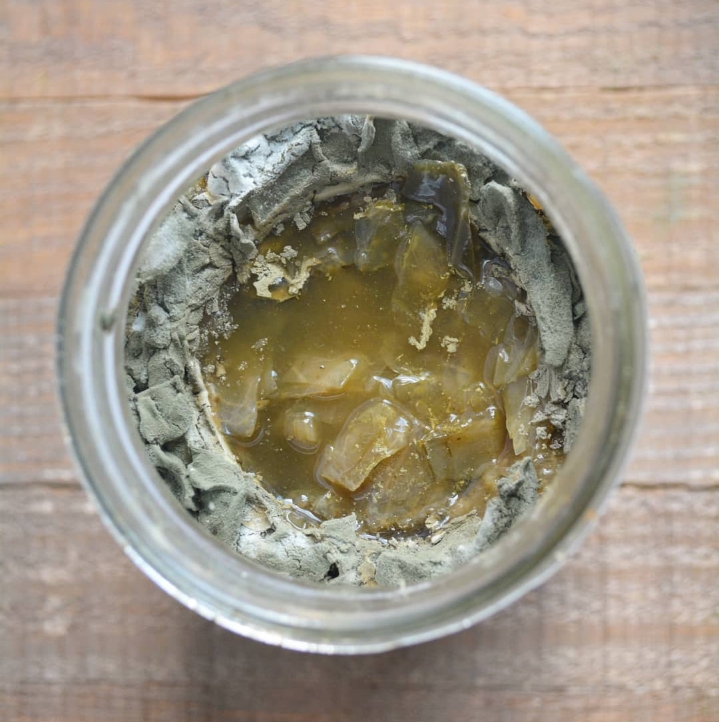
Meg Chamberlain, Fermenti Farm: You must allow the ferment to thrive by creating a favorable environment with “Good Kitchen Practices.” So, to prevent mold in your ferment start by using only purified water, like reverse osmosis, distilled or boiled and cooled and-no tap water(municipal). Only use vegetable-based soap that is NOT anti-bacterial, like a good castile soap. Finally, only use dry fine Sea Salt, no mineral/no gourmet or iodized. Keep Fermenting and do not get discouraged! #youcanfermentthat #diyfermentation #idfermentthat
Courtlandt Jennings, Pickled Planet: Preventing mold when making sauerkraut is all about a controlled atmosphere. How well you maintain your situational cleanliness and fermenting atmosphere is my best clue for you. There are many ways to control atmosphere and every situation will be different based on many factors but be dillegent and your ferments will improve with practice.
This may not seem like an answer but it’s directional… as is most advice unless dealing with a consultant. Good luck and may the ferment force be with you!
- Published in Food & Flavor, Science
Fermentation Booms During Pandemic
In a matter of days, the novel coronavirus outbreak dramatically changed grocery shopping. Empty grocery store shelves have become a ubiquitous symbol globally of home quarantine.
Sales exploded for pantry staples like dried beans (62.9%), powdered milk (126.3%) and rice (57.5%). But another grocery quarantine must-have item is emerging – fermented food and drink. Sales are up for kombucha (10.1%), natto is selling out in Japan, yogurt is selling out in Europe and pickle and sauerkraut sales in Russia are up 79%. Fermentation brands are reporting some of their biggest sales during the month of March, as much of the nation was forced into self-isolation to prevent the spread of COVID-19.
“For fermented food, it’s an interesting time. We’re an immune boosting type of food, so our sales are skyrocketing. We’ve had the best month we’ve ever had in business,” says Drew Anderson, CEO of Cleveland Kitchen and TFA board member. Cleveland Kitchen makes sauerkraut and fermented dressings and marinades. “It is bittersweet. Obviously, we want this virus to go away. But we’re seeing the fermentation industry as a whole, the one benefit is it’s driving a lot of trial. People say ‘I heard fermented food is supposed to be good for you, I’m cooking more, why not grab a pack of kraut.’”
Though sales are high, brands are changing their operation model. Rather than running two shifts of processing at Cleveland Kitchen, they’re down to one. Employees must take daily temperature readings before work, stop for mandatory handwashing breaks and use new Purell hand sanitizing stations.
“Sales are up overall, but we have had to implement our emergency sanitation protocols to continue production,” says Meg Chamberlain, CEO of Fermenti, LLC. The North Carolina-based brand sells a variety of vegetable ferments, teaches fermenting workshops and hosts annual the annual WNC Fermenting Festival. Their staff is under voluntary home quarantine – which means staff only goes from work to home. “Overall our company is proving resilient and we are hopeful to continue to provide Fermenti to our community.”
Because food production is considered essential business, licensed fermentation companies have not been forced to stop working during the coronavirus outbreak.
Aneta Lundquist, CEO of 221 B.C. Kombucha, has been posting videos to her Instagram stories of the Florida based kombucha processing facility. Lundquist says employees are working overtime to deliver orders.
“Our orders during the global pandemic have spiked. Consumers have gone full blown ‘healthy’ food during this health crisis,” she says. “Now is the time to make a switch from over-processed and denaturalized pseudo foods to real, natural and unprocessed foods that nourish our body, mind and spirit and help building a strong immunity.”
Lundquist adds customers need to “think of kombucha, kimchi, sauerkraut and other fermented fruits and vegetables as microbiome rock stars!…Always choose wildly fermented foods.”
“Remember it is about diversity and the quality of microorganisms, not just quantity. You can only achieve this by fermenting traditionally.”
Keenan Smith, CEO of Goodwolf Kefir in Portland, agrees. He says: “The probiotic and fermented space will increase as people have an increase in health awareness and want a better functioning immune system.” They are home delivering their kefir, and donating a
Brands are getting creative with their marketing, too. Goodwolf Kefir is home delivering kefir to the Portland area and donating a proceed of sales to their local food bank. Cultured South and Golda Kombucha have setup a pick-up fridge at their Atlanta location where customers can prepay for an order online, get a secret code to unlock the fridge and grab fermented food and drinks. Wild Kombucha in Baltimore is offering free, local, “no human touch” home delivery for their 12 pack bottles. 28 Mile Vodka & Distillery in Illinois have converted their distillery to make hand sanitizer that they call “Fool’s Gin.” The CEOs of Miyoko’s Creamery and Lifeway Kefir are both using the brands Instagram accounts to share recipes using their product.
Outside the U.S., though, different government rules are restricting fermentation brands from operating during the global outbreak. In India, Mountain Bee Kombucha has halted operations during a 21-day lockdown.
“There is no question that our business is impacted immensely, one for the fact that we are still quite small-scale which supplies directly to a handful of local grocery stores. Currently those grocery stores have been working at limited capacity and/or temporarily shut,” said founder and head brewer Honey Islam. “Another reason for lesser business in these times is due to the lack of awareness in the Indian market about fermented foods, especially kombucha. We are engaged in educating our customers as well as spreading awareness in the community via workshops, classes, 101 sessions, pop-ups, all these channels are education are currently disrupted which stalled our efforts in bringing kombucha awareness to the masses.”
Mountain Bee Kombucha is focusing on educating through Instagram videos and YouTube tutorials.
- Published in Business
Firefly Kitchens Aims to “Put the Sexy in Sauerkraut”
Julie O’Brien of Firefly Kitchens in Seattle wants to “put the sexy in sauerkraut.” She says: “It’s everyone’s goal to make their meals look beautiful and taste beautiful, but wouldn’t it be great if somebody also felt good after eating what they make? By tossing in a dash of kraut, you’re getting that digestive boost and support, so you’re not hung up on the couch in sweatpants after eating a big meal.” O’Brien began fermenting 14 years ago after fermentation piqued her interest during a nutrition program. The high density of micronutrients in fermented foods originally appealed to her. She’s survived the unstable Seattle food scene by championing the traditional food craft.
Read more (Seattle Pi)
- Published in Business
Bubbling Over: Is Fermentation More Than a Fad
We asked three fermentation experts if recent popularity of fermented foods is a fading trend or a new food movement. These industry professionals weigh in on their predictions for fermentation’s future. The fermenters include: Bri Warner (CEO of Atlantic Sea Farms, a commercially viable seaweed farm that makes kelp kraut and kimchi), Nicholas Gregory (owner of Pulp Hot Sauce, an Atlanta-based fermented condiment brand), Joshua Rood (co-founder and CEO Dr Hops Kombucha beer, a health-conscious alcohol).
Do you think the surge of fermented food and drinks is a trend will disappear or a new food movement here to stay?
Bri Warner, CEO Atlantic Sea Farms: “Now that we have a robust understanding of how good gut health effects overall health, I think fermentation is here to stay. I do think the category will continue to innovate to remain relevant, with a stronger focus on quality ingredients that are good for people, planet, and, in our case, oceans!”
Nicholas Gregory, owner Pulp Hot Sauce: “I think the current fermented food movement is here to stay. We are at an intersection of technology, science and health further than we have ever seen in human history. The internet, television, several seminal books and air travel have given us unprecedented exposure and access to information. This exposure and access to food and world cultures is more in depth than ever before. Including the food history and traditions of those cultures. Combine that awareness with a relatively intelligent and sophisticated medical system; an understanding of healthy lifestyles, a willingness to make healthy decisions, an understanding of the benefits of a healthy gut biome and how it all correlates to a longer, happier, healthier life. Along with a craving for umami and fermented funky flavors for a growing number of the population. I believe we are in the middle of a movement that shows no signs of slowing down or going away anytime soon. In fact, I see it only becoming more popular, more normal, more accepted, more diverse, more creative and more exciting in the decades to come.”
Joshua Rood, co-founder and CEO Dr Hops Kombucha beer: “As co-founder and CEO of Dr Hops Kombucha Beer, I appreciate that there is currently a powerful trend towards living, fermented foods. But answering the question of whether or not that will continue is repugnant. We here at Dr Hops are driving that trend! We are not playing the game of hoping that it will simply continue. We are committing ourselves, each day, to the life-enhancing awesomeness of fresh, authentic, fermented foods and beverages. Please join us in that! Join us in leading the health-conscious food and beverage revolution!”
- Published in Business
Rebecca Wood on the Delicious Taste of Fermented Foods
“Why do some foods like chocolate, wine and cheese taste so delicious? Fermenting magically transforms their original ingredients into something more desirable. Besides upping flavor, some lactic-acid ferments, such as homemade sauerkraut, actually strengthen your immune system.”
Rebecca Wood, “Fermented Foods Strengthen Immune System“
- Published in Food & Flavor

